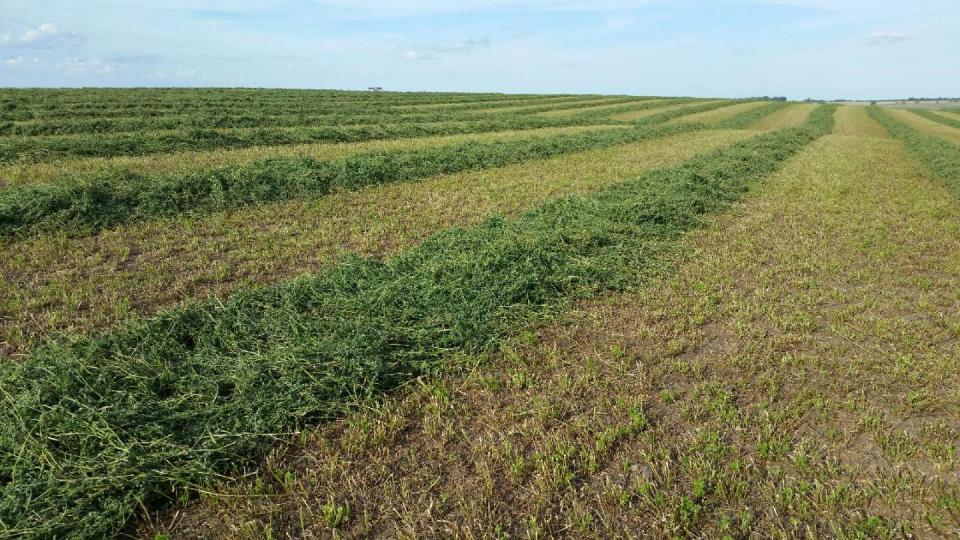
Pasture and Forage Minute: Alfalfa Cutting Prep and Weevil Control
Ready for First Cutting?
Working on getting corn and beans planted? Don’t look now, but alfalfa harvest is approaching fast.
With a late start this spring, we’ve been busy planting and turning animals out to grass. It isn’t time to relax just yet because your alfalfa may soon be ready to cut.
As we look at alfalfa conditions across the state, first cutting of alfalfa should be happening soon. Folks needing high quality alfalfa for dairy cows or for a cash crop may be looking for the next available good weather period and planning their harvest.
Being aggressive on the first cutting is critical if high forage quality is needed. Alfalfa’s forage quality changes faster during the first spring growth than at any other time of the year. Plants are maturing and temperatures are increasing; both causing quality to decline. So don’t delay your first cutting if high quality is needed.
But what about alfalfa for beef cows? That might be a little different story, especially if you need to rebuild hay supplies. Normally, we get our highest total yield by waiting until alfalfa is near full bloom. Not only is yield highest, this also uses available soil moisture most efficiently for alfalfa growth. Despite some recent rain, some dryland fields may need a bit more rain for good summer and fall harvests since most deep subsoil moisture was depleted last year. Even if we end up with a dry summer, with a good first cut you will at least have some hay of decent enough quality to feed your beef cows next winter.
Timing of hay harvest is important whether your needs are for high quality or for high yield. With alfalfa ready to cut soon this spring, don’t miss your best time.
Managing Alfalfa Weevil

Be careful not to overlook wilting and browning leaves in your alfalfa fields since this could be a sign of an alfalfa weevil infestation. Scouting alfalfa fields now and monitoring larval and adult weevil counts prior to the first cutting is important to determine if management strategies like early harvest or insecticide application are needed. Although drought and cold injury can cause leaf wilting, alfalfa weevil can also wilt and brown alfalfa plants. Since weevil larvae spend nearly all of their time feeding on plants, they can rapidly deteriorate potential hay quality.
Scouting can be completed either using a sweep net or collecting random samples. For hand sampling, it is recommended to gather 10 alfalfa stems cut at ground level from at least five sample locations within each alfalfa field. Next, shake the larvae off the collected stems into a deep-sided bucket. Count the larvae in the bucket and calculate average larvae per stem. Weevil larva are small (1/16- to 3/8-inch long) pale yellow to dark green insects that curl into a C-shape when disturbed.
Next calculate your economic thresholds for determining if an insecticide application or early alfalfa cutting harvest might be beneficial. Economic threshold charts are available at CropWatch.
Final treatment decisions are based on average weevil larvae per stem counts, plant growth stage, treatment costs and projected forage value. For example, insecticide treatment and/or early cutting may be recommended if you count more than two weevil per stem at the early bud stage of developing alfalfa valued at $100 per ton.
Alfalfa Irrigation Before First Cutting
Low soil moisture levels in many areas across the state may mean irrigating alfalfa before the first cutting. Have you considered irrigating early?
Early season watering is not a typical practice, but when soil profiles are dry, it needs to be considered. For soil that is still dry from last fall, now is the time to irrigate alfalfa, building moisture up in the profile for later in the year when the heat of the summer increases water requirements.
Spring irrigation will make irrigating in summer easier and more efficient for the alfalfa by encouraging deep root growth. During the peak of summer heat and growth, alfalfa water needs may reach one half inch per day. Shallow roots are unable to keep up with increased demand during the summer heat. Instead, alfalfa relies upon deep roots that can extend down to depths of 8 feet. Irrigating only enough to maintain growth in the summer will promote the growth of shallow roots and end up increasing demand in the long run.
Alfalfa also doesn’t like overly wet feet. To keep up with summer demand, the soil surface and first few inches may stay too wet. Oxygen needs for roots will be limited and performance with suffer.
Finally, be sure to have adequate moisture in your alfalfa before cutting. If irrigating occurs before the alfalfa plant has begun to regrow after cutting, weed growth will be promoted instead.
Water early to make sure the top six feet of soil have ample water for the summer months.
Online Master of Science in Agronomy
With a focus on industry applications and research, the online program is designed with maximum flexibility for today's working professionals.
